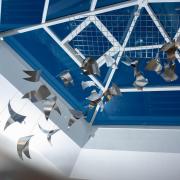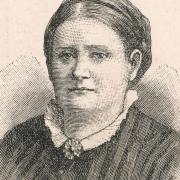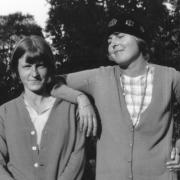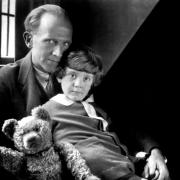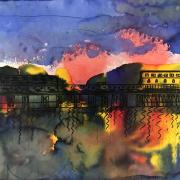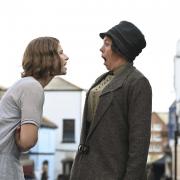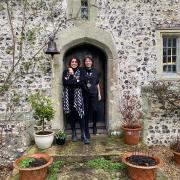Perhaps you’ve seen her work while riffling through art cards in a Sussex bookshop. Or noted her crisply-cut wood engravings in the landmark 2017 Towner exhibition in Eastbourne, Ravilious & Co: The Pattern of Friendship. Either way, Tirzah Garwood isn’t a name that readily trips off the tongue.
‘In a perfect world,’ says social historian Louise Peskett, ‘Garwood would be a household name and acknowledged as one of the most original and distinctive figures of 20th-century British art. Instead, as a mother of three children and the wife of the much more famous artist Eric Ravilious, she is often confined to the shadows of art history.’
Thankfully, Garwood is enjoying a well-earned renaissance. In 2012 her autobiography, Long Live Great Bardfield, was published by Persephone Books to considerable acclaim. Then, in 2019, the Fry Art Gallery in Saffron Walden in Essex mounted a joint exhibition, Mr and Mrs Ravilious, which, for the first time, told the story of the couple from an intertwined personal perspective.
Tirzah's Story
And now Eiderdown Books, which re-examines the work of overlooked modern women artists, has produced an illuminating retelling of Garwood’s story by art historian Lotte Crawford. What emerges is a woman who excelled in wood engraving, abstract marbled patterns, collage, and a style of surreal oil painting which fused English romanticism with a rich inner world.
Garwood was born into a wealthy family in Kent and enjoyed a solidly respectable Edwardian childhood which took her to Littlehampton, and then Eastbourne, as the family relocated to different postings held by Garwood’s father, an officer in the Royal Engineers. Although she was christened Eileen Lucy Garwood, her four siblings affectionately called her ‘Tirzah’.
A photograph of Garwood taken by Edwin Smith in 1950 depicts a slender, poised and confident woman with well-defined, angular features and intelligent, watchful eyes. Her friend, the writer and painter Olive Cook, described her as having a ‘sharp awareness and relish of oddities and foibles’, as well as a ‘caustic wit’.
Garwood’s early wood engravings and prints confirm that she was already an accomplished artist when she arrived at Eastbourne School of Art, aged 17, in 1925. Her detailed illustrations of the natural world, such as Daddy Long Legs and Spider (1927-28), which depicts two insects engaged in a gory battle, demonstrated her ability to create dynamic compositions using contrasting linework. By 1927 she had started exhibiting with the Society of Wood Engravers and was awarded the Royal Drawing Society’s silver medal, her work feted for its humour and dash of eccentricity.
Love and Art
It was at Eastbourne that she also met her future husband, Ravilious, who was teaching drawing, watercolour and wood engraving. She noted that he was ‘smart’ and ‘shy’ and had ‘diffident manners not unlike those of a curate’, though she recognised that ‘with my family’s training behind me, I quickly spotted that he wasn’t quite a gentleman’. To Garwood’s family, Ravilious, the son of a shopkeeper, was not at all the right sort, but in 1930 she married him anyway, viewing his creative and cultural difference as an escape from her staid upper-middle-class existence.
By this time, she had become an established wood engraver, a medium which had seen a revival in the inter-war period, particularly in book illustration. Like many of her contemporaries, she used sharp linework and monochromatic printing techniques, but what made her distinctive was her focus on the lives of upper-middle class English women and girls.
The Crocodile (1930) shows a receding line of Eastbourne schoolgirls in ribboned straw hats walking along a curved pavement, their shadows bouncing off a carefully-delineated brick wall. In The Train Journey (1930), Garwood depicts herself as a modish rail passenger with a flapper-style bob and pussy-bow blouse, opposite two slumbering male commuters. Crawford describes it as ‘a vivacious expression of womanhood set in the formal austerity of the train carriage’.
Sadly, Garwood’s burgeoning wood engraving career didn’t survive her marriage. In the 1930s it remained socially unacceptable for women to work after wedlock, though she soon turned her focus instead to designing motifs for patterned papers, used for book bindings and their endpapers. She engraved fluid, organic patterns into a small block of wood which, when printed multiple times, created an infinitely repeating and delicate abstract pattern.
Domestic Drudgery
Between 1932 and 1934 Garwood and Ravilious upped sticks from London, where they had moved after their marriage, to rent a house with fellow artists Edward and Charlotte Bawden at Great Bardfield in Essex. But this seeming domestic idyll, united by a common artistic cause, didn’t last for long because Ravilious, who had a wandering eye, soon began an affair with the artist Diana Low. The deceit was multi-layered. Not only was Low a mutual friend, but while Ravilious was away gallivanting, Garwood, as she confided in her diary, was struggling with the drudgery of her newly-acquired domestic duties as a married woman.
She relieved the tedium by producing marbled papers for lampshades with Charlotte Bawden, something she continued alone when Garwood and Ravilious moved into a home of their own at neighbouring Castle Hedingham.
The patterns she produced at this time, says Crawford, are among her most remarkable, not least because marbling, where colour is suspended in thickened water and manipulated into various patterns, is an exceptionally difficult process. But Garwood, whose designs were again influenced by organic forms and arranged like cells under a microscope, managed to create a series of harmonious and unbroken repeat patterns which reveal her exceptional technical precision.
By this time Garwood had become a mother, but her earliest experiences of pregnancy and childbirth were bitterly interlaced with romantic complications. Ravilious followed up his brief entanglement with Low by starting a longer and more serious affair with another mutual friend and artist, Helen Binyon, for whom he attempted to leave Garwood. The situation was compounded, in 1936, by Garwood’s own passionate involvement with the artist John Aldridge, until Aldridge’s wife Lucie discovered and put an end to the affair.
Although Garwood’s autobiography suggests a certain degree of ambivalence about Ravilious’s second affair, she later conceded that ‘...it was sad for me, because I couldn’t look forward to having my baby when I knew Eric hated the thought of being a father and all the responsibility that it implied.’
Cancer Diagnosis
Despite these difficulties, Garwood cherished motherhood and often drew tender sketches of her children. But tragically, in the spring of 1942, she was diagnosed with breast cancer and underwent an emergency mastectomy. That same year, shortly after her first operation, Ravilious was dispatched to Iceland for his third commission as a war artist and his plane never returned from patrol. Garwood received a telegram from the Admiralty explaining that he had been ‘reported missing – presumed dead’.
Mercifully, in 1946 she found love again, marrying Henry Swanzy, a radio producer for the BBC’s General Overseas Service. By this time she had branched out into collage – 3D paper constructions of houses and shops which have a bewitching dolls-house-like quality.
This was her happiest and most productive period, and she also painted no fewer than 20 oil canvases. They have an other-worldly atmosphere but also an unmistakeable British feel. Her collection of 19th-century naive paintings appear to have been the inspiration behind Etna (1944) which depicts a brightly-coloured steam training chugging through an idyllic Sussex chalkland landscape.
It was to prove the lull before the storm, however. By 1950 her cancer had returned and she was forced to move into a care home near Colchester in Essex, although she continued to paint. Garwood died on March 27, 1951, aged just 42, but her exuberance for life remained with her to the end. More than 70 years after her death, her formidable talent is finally being recognised. The icing on the cake would surely be a retrospective exhibition at Towner celebrating this extraordinarily gifted artist. It’s time she stepped out of Ravilious’s shadow once and for all.
•This feature is based on Tirzah Garwood by Lotte Crawford which is published by Eiderdown Books at £10.99; eiderdownbooks.com










